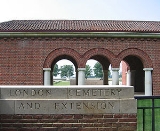
London Cemetery and Extension
Encyclopedia
The London Cemetery and Extension is a Commonwealth War Graves Commission
cemetery at High Wood
near Longueval
, France
. It is the third largest of the Somme battlefield cemeteries, containing 3,872 World War I
burials.
The cemetery stands directly opposite High Wood as it exists today. This area was the centre of fierce fighting in 1916 and the first interments at what would become the London Cemetery were 47 soldiers of the 47th (London) Division killed in the Battle of Flers-Courcelette
on the 15th September. These soldiers, barely a handful of those who had lost their lives in the attack, were buried in a large shell
hole in the days following the battle. By the time of the Armistice
, further burials had taken place, bringing the number of graves to 101.
The Extension of the cemetery came in the years following the war when graves from the surrounding battlefields were transferred to the land around the London Cemetery, greatly increasing its size. Like a number of other cemeteries and memorials in the area, the London Cemetery and Extension was designed by architect Sir Herbert Baker
. The original battlefield cemetery was left intact within The London Cemetery and Extension following its redesign.
Although the cemetery primarily contains World War I graves, 165 soldiers were reburied there after World War II
. These graves are together in one section at the far end of the cemetery.
Commonwealth War Graves Commission
The Commonwealth War Graves Commission is an intergovernmental organisation of six independent member states whose principal function is to mark, record and maintain the graves, and places of commemoration, of Commonwealth of Nations military service members who died in the two World Wars...
cemetery at High Wood
High Wood
High Wood is a small forest near Bazentin le Petit in the Somme département of northern France which was the scene of intense fighting for two months from 14 July to 15 September 1916 during the Battle of the Somme.-Background:...
near Longueval
Longueval
Longueval is a commune in the Somme department in Picardie in northern France.-Geography:Longueval is located 24 miles northwest of Amiens on the D919 road, at the junction with the D8....
, France
France
The French Republic , The French Republic , The French Republic , (commonly known as France , is a unitary semi-presidential republic in Western Europe with several overseas territories and islands located on other continents and in the Indian, Pacific, and Atlantic oceans. Metropolitan France...
. It is the third largest of the Somme battlefield cemeteries, containing 3,872 World War I
World War I
World War I , which was predominantly called the World War or the Great War from its occurrence until 1939, and the First World War or World War I thereafter, was a major war centred in Europe that began on 28 July 1914 and lasted until 11 November 1918...
burials.
The cemetery stands directly opposite High Wood as it exists today. This area was the centre of fierce fighting in 1916 and the first interments at what would become the London Cemetery were 47 soldiers of the 47th (London) Division killed in the Battle of Flers-Courcelette
Battle of Flers-Courcelette
The Battle of Flers-Courcelette, was a battle within the Franco-British Somme Offensive which took place in the summer and autumn of 1916. Launched on the 15th of September 1916 the battle went on for one week. Flers-Courcelette began with the overall objective of cutting a hole in the German...
on the 15th September. These soldiers, barely a handful of those who had lost their lives in the attack, were buried in a large shell
Shell (projectile)
A shell is a payload-carrying projectile, which, as opposed to shot, contains an explosive or other filling, though modern usage sometimes includes large solid projectiles properly termed shot . Solid shot may contain a pyrotechnic compound if a tracer or spotting charge is used...
hole in the days following the battle. By the time of the Armistice
Armistice with Germany (Compiègne)
The armistice between the Allies and Germany was an agreement that ended the fighting in the First World War. It was signed in a railway carriage in Compiègne Forest on 11 November 1918 and marked a victory for the Allies and a complete defeat for Germany, although not technically a surrender...
, further burials had taken place, bringing the number of graves to 101.
The Extension of the cemetery came in the years following the war when graves from the surrounding battlefields were transferred to the land around the London Cemetery, greatly increasing its size. Like a number of other cemeteries and memorials in the area, the London Cemetery and Extension was designed by architect Sir Herbert Baker
Herbert Baker
Sir Herbert Baker was a British architect.Baker was the dominant force in South African architecture for two decades, 1892–1912....
. The original battlefield cemetery was left intact within The London Cemetery and Extension following its redesign.
Although the cemetery primarily contains World War I graves, 165 soldiers were reburied there after World War II
World War II
World War II, or the Second World War , was a global conflict lasting from 1939 to 1945, involving most of the world's nations—including all of the great powers—eventually forming two opposing military alliances: the Allies and the Axis...
. These graves are together in one section at the far end of the cemetery.

